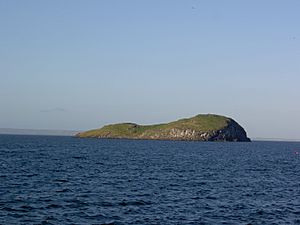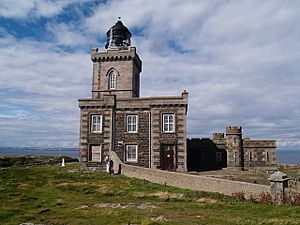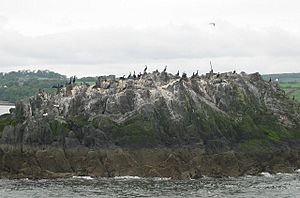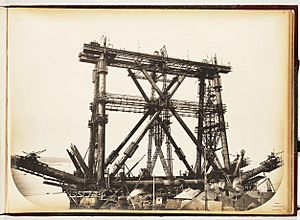Islands of the Forth facts for kids
The Islands of the Forth are a group of small islands located in the Firth of Forth in Scotland. This area is on the east coast, where the River Forth meets the sea. Most of these islands are found in the open waters of the Firth, between the areas of Lothian and Fife. Many of them are east of the city of Edinburgh. A couple of islands are further west, inside the river itself.
These islands have a fascinating mix of rock types and a long history. Many have been important for churches and even used as military bases over hundreds of years. You'll find lighthouses and other navigation helpers on them, with one lighthouse dating back to the 1600s! Today, only one island still has people living on it all the time. The area is also home to lots of different birds and sea creatures. For example, the scientific name for the northern gannet bird comes from its strong connection to the Bass Rock. There aren't many islands off eastern Scotland, and most of the bigger ones are in this special group.
Contents
Exploring the Islands of the Forth
Where are the Forth Islands Located?
The islands are spread out across the Firth of Forth. The furthest east is the Isle of May, located off the coast of Fife, near Crail. To the south, in the outer part of the Firth, there's a group of islands off East Lothian, close to North Berwick and Gullane. From east to west, these are the Bass Rock (also called "The Bass"), Craigleith, Lamb, Fidra, and Eyebroughy.
A second group of islands is found in the inner part of the Firth of Forth. Inchkeith and Inchcolm are off Kinghorn and Aberdour on the north shore. Inchgarvie sits in the middle, between North Queensferry and South Queensferry. Inchmickery and Cramond Island are closer to Edinburgh on the south shore. Finally, Alloa Inch and Tullibody Inch are the furthest west, in the river part of the Forth.
Only one of these islands, Inchcolm, has had people living there recently. However, many of them used to have monasteries, hermitages, lighthouses, or forts in the past. In the late 1800s, the Isle of May had over 20 residents. Many of the island names start with "Inch-", which comes from Innis, the Gaelic word for "island".
What are the Forth Islands Made Of?
Most of the islands are what's left of ancient volcanic rock that pushed up from deep underground. The Isle of May is made of a dark-grey rock called basalt. Fidra is also mostly basalt, and The Bass Rock is a volcanic plug, which is like the hardened core of an ancient volcano. Craigleith is made of a rock called essexite, which is even used to make curling stones! Cramond Island is made of dolerite. Inchmickery and Inchgarvie also come from volcanic activity.
Scientists have studied the land under the Firth. They found that Inchgarvie is just the very top of a much larger rock formation. It's similar to how Edinburgh Castle and the Royal Mile were formed by glaciers moving across the land. The small tidal island of Eyebroughy is about 1.5 kilometres (1 mile) west of Fidra. It's made of a rock called trachyte and formed during the early Carboniferous period.
Most of Inchkeith is volcanic, but it also has layers of sandstone, coal, limestone, and shale. The shale even contains many fossils! Inchkeith also has several natural springs. Inchcolm is similar, with a mix of greenstone, sandstone, shale, and limestone.
Wildlife and Nature on the Islands
Birdlife and Conservation Efforts
The Firth of Forth is a very important area for nature conservation. It has many different natural places, like wide mudflats, rocky beaches, and saltmarshes. The saltmarshes, especially on Alloa Inch, are covered in special plants like saltmarsh rush and sea aster.
The inner Firth is a crucial spot for large numbers of wintering wildfowl and wading birds. You can find birds like shelduck, knot, redshank, great crested grebe, teal, and goldeneye here. The outer islands are important nesting places for many seabirds.

The Bass Rock is home to over 150,000 nesting northern gannets! It's the biggest single rock colony of gannets in the world. If you look at the rock from the mainland, it often looks white. This is because of the huge number of birds and their droppings. The scientific name for this gannet, Morus bassanus, comes from the rock itself. People used to call the bird the "solan goose" and thought its eggs and meat were special treats. In 1850, almost 2,000 birds were harvested from the rock. Other birds on the Bass Rock include guillemot, razorbill, cormorant, puffin, eider duck, and many types of gulls.
Craigleith is close to North Berwick's harbour. It used to be a place where rabbits were raised for food. However, a disease called myxomatosis wiped out the rabbits in the 1950s. The Atlantic puffin colony on Craigleith was once one of the largest in Britain, with 28,000 pairs. But from 1999 onwards, a plant called tree mallow started to take over. This plant choked the puffins' burrows, making it hard for them to raise their chicks.
In 2007, a five-year project called SOS Puffin was started by the Scottish Seabird Centre in North Berwick. Hundreds of volunteers have worked hard to remove the tree mallow from the island. They are taken to the island by boat during the winter when the puffins are at sea. There are now signs that the puffins are starting to return to the island to breed. Fidra, Inchmickery, and Eyebroughy are RSPB nature reserves. Eyebroughy is especially known for its cormorants. Over 240 types of birds and 60 types of seaweed have been found on the Isle of May.
A Look Back: History of the Forth Islands
Ancient Times and Early History
Several islands have remains from very old cultures, whose names we don't even know. Over time, different groups of people, including Celts, Norse (Vikings), and English speakers, have influenced the islands. This is why their names come from different languages. The islands were also attacked by Vikings a long time ago.
Royal Experiments and Quarantine
In the 1400s, during the time of King James IV, Inchkeith was the site of a very unusual experiment. A historian named Robert Lyndsay of Pitscottie wrote that in 1493, King James sent a woman who couldn't speak and two babies to the island. He wanted to see what language the babies would speak if they grew up without hearing anyone talk. He thought it might be the "original" language, or the language of God. We don't have a clear answer, but Lyndsay of Pitscottie said "some say they spoke good Hebrew."
In 1497, Inchkeith and Inchgarvie were used as isolated safe places. Later, in 1589, Inchkeith was used again to quarantine people from a ship that had the plague. More plague sufferers came from the mainland in 1609, and in 1799, Russian sailors who died from an infectious disease were buried there.
Inchcolm is even mentioned in Shakespeare's famous play Macbeth, where it's called "Saint Colmes ynch."
Military Forts and World Wars
Inchcolm was attacked by English soldiers during the Wars of Scottish Independence in the 1300s. In the 1500s, Inchkeith, Inchcolm, and Inchgarvie were all taken over by the English. The Earl of Somerset stationed soldiers on the islands in 1547 after the Battle of Pinkie Cleugh. His soldiers, many of whom were Italian, built a large square fort on Inchkeith where the lighthouse is now. However, a combined French and Scottish force drove them out in 1549.

Only Inchcolm was fortified during the Napoleonic wars. Inchkeith was also fortified in 1880, along with Kinghorn. Inchgarvie got its weapons in the early 1900s. During the First World War and the Second World War, Inchmickery, Inchcolm, and Cramond Island were part of a line of guns that protected anti-submarine barriers across the river. There's a popular story that the buildings on Inchmickery were designed to make the island look like a battleship from far away. However, this isn't true. The buildings were placed to give the guns the best firing positions and to fit as many soldiers as possible. These buildings were later used to film parts of the movie Complicity.
Islands and the Church

Many of the islands have connections to early Christian groups called Culdees and had small chapels. Several saints are also linked to the islands. St Thaney (or Thenaw) was supposedly the mother of St Kentigern. Legend says her father, King Leudonus, cast her adrift in a boat without oars beyond the Isle of May. This event supposedly led to a lot of fish appearing in the nearby seas. St Adrian of May was killed there by invading Danes in 870. He was buried in a stone coffin on the island, but it's said his coffin floated across the Firth to a churchyard in Anstruther. The Isle of May has a long history of religious activity, and you can still see parts of a 13th-century Benedictine church there.
The Irish missionary Saint Baldred of Tyninghame lived on The Bass Rock in the 700s. There's also a ruined chapel from the 1100s on Fidra, dedicated to St Nicholas. Inchcolm has links to St Columba. King Alexander I was once stranded on Inchcolm and decided to make it the site of an Augustinian monastery. In the 600s, St Adomnán of Iona started a "school of the prophets" on Inchkeith after meeting St Serf there. Inchmickery's name might come from the Gaelic words for "island of the vicar."

Many of the islands help guide ships. There are several lighthouses and other devices to help ships in the busy waters near the ports of Leith and Rosyth.
In 1803, work began on the Inchkeith Lighthouse, designed by Thomas Smith and Robert Stevenson. The lighthouse is 67 metres (220 feet) tall and started working in 1804. The Fidra light was built in 1885 and became automated (run by machines) in 1970.
The light on the small rock of Oxcars was automated very early, in 1894. Back then, it was controlled by a clockwork timer and powered by gas delivered weekly from Granton. A lighthouse was built on the Bass Rock in 1902.
The Isle of May light has a very long history. It started working in 1635 with a simple coal-fired structure. The current building was built in 1816. It became a "rock station" (meaning it was built on a rock far from land) in 1972 and was automated in March 1989. The island is owned by the Northern Lighthouse Board, but it's managed by Scottish Natural Heritage as a national nature reserve.
You can't reach most of the islands by public transport. However, Inchcolm has a regular boat service during the summer.
List of Forth Islands
| Island | Gaelic Name | Meaning of name | Location | Area (ha) | Highest point | Last inhabited |
|---|---|---|---|---|---|---|
| Alloa Inch | Unknown | Alloa island | c. 33 | <5 | 20th century? | |
| Bass Rock | Unknown | Possibly from Gaelic bathais, meaning "forehead". | 7.5 | 107 | 1970s | |
| Craigleith | Creag Lìte | Rock of Leith | 5 | 24 | Inhabitation unlikely | |
| Cramond Island | Unknown | island of the fort on the Almond river | 7.7 | 28 | Possibly World War II | |
| Fidra | Unknown | From the Norse for "feather island" | 10 | 20 | 1970 | |
| Inchcolm | Innis Choluim | Calum/Malcolm or Columba's island | 9 | 34 | First decade of the 21st century | |
| Inchgarvie | Innis Garbhach | rough island | 0.83 | 19 | Probably World War II | |
| Inchkeith | Possibly Innis Cheith or Innis Coit. | wooded island | 20 | 59 | 1986 | |
| Inchmickery | Possibly Innis nam Bhiocaire | Possibly "island of the vicar" | <5 | 14 | Probably World War II | |
| Lamb | Unknown | From a common Norse name for a small island | 0.5 | 15 | Inhabitation unlikely | |
| Isle of May | Eilean Mhàigh | Possibly "gull island" | 45 | 50 | 1989 | |
| Tullibody Inch | Unknown | Tullibody island | 6 | <5 | Unknown |
Outer Forth Islands: East to West
The Isle of May is in the north of the outer Firth of Forth, about 8 kilometres (5 miles) off the coast of mainland Fife. It is 1.8 kilometres (1.1 miles) long and less than 0.5 kilometres (0.3 miles) wide. Its total area is 45 hectares (111 acres), making it the largest of the Forth islands. Although people lived there often in the past, no one has been recorded as living there since the lighthouse became automated. Rona is a small tidal island to the north, connected to the main island by a bridge. Further north are North Ness, the Mars Rocks, and Norman Rock. Clett and the Middens are tall rock formations called stacks to the east, and The Pillow is a small rocky island called a skerry to the southeast. Maiden Rocks and Maiden Hair are just offshore to the south.
The Bass Rock is about 2 kilometres (1.2 miles) offshore and 5 kilometres (3 miles) north-east of North Berwick. This island has very steep sides and no one lives on it now, but people lived there for many centuries. It has a castle from the 1300s, which was later used as a prison. There are also remains of a chapel built around 1491. The Lauder family owned the island for almost 600 years. Now, it belongs to Sir Hew Dalrymple, whose family bought it in 1701. The Bass Rock appears in many stories, including Robert Louis Stevenson's Catriona. At 7.5 hectares (18.5 acres), the Bass Rock is the second largest of the Forth islands. The Middens is a small stack just offshore to the northwest.
Craigleith is north of North Berwick harbour. Sir Hew Dalrymple also bought it from North Berwick Town Council in 1814.
The Lamb is an uninhabited island about 100 metres (330 feet) long and 50 metres (160 feet) wide. It's surrounded by small rocky islands called skerries, named North Dog and South Dog. Other skerries between it and the shore include Bubbly Buss, the Law Rocks, and the Hummel Ridges. In February 2009, the famous Israeli paranormalist Uri Geller bought the island for £30,000.
Fidra, sometimes called Fetheray in old texts, is 4 kilometres (2.5 miles) north-west of North Berwick. Like the nearby islands, it was formed by volcanic activity and has a large population of seabirds. You can reach it using a simple jetty on its eastern shore. It's said that R. L. Stevenson based his map of Treasure Island on the shape of Fidra. The island also has smaller companion islets called North Dog and South Dog. Castle Tarbet is another islet to the south that becomes separate from the main island at high tide.
Inner Forth Islands: Closer to Shore
Inchkeith is close to the shores of Fife. Its history is mostly about religion, its use as a quarantine island, and military events (as mentioned earlier). It is currently owned by Tom Farmer, who founded Kwikfit, but he doesn't live there.
Inchmickery is about 8 kilometres (5 miles) east of Inchkeith and about 3.5 kilometres (2.2 miles) north of the city of Edinburgh. It's only about 100 metres (330 feet) by 200 metres (660 feet) in size. Rocks known as the Cow and Calf are to the north. Beyond that, about halfway to Inchcolm, are the Oxcars, which are a danger to ships and marked by a permanent light.
Inchcolm is the only island in the Firth that has had people living on it recently. In the 2001 census, two people lived there, but no one was recorded in the 2011 census. There is a person employed by Historic Scotland who lives there to look after the island and run the shop during the summer. In the 1300s, John of Fordun recorded the name as "Euomonia." There are various small rocky islands in the sea to the north, including Swallow Craig, Car Craig, Meadulse, and Craigdimas.
Inchgarvie's name comes from Innis Gharbhaidh, which is Scottish Gaelic for "rough island" or possibly "Garbhach's island." This island has a long history of being fortified and is now part of the famous Forth Bridge. In 1878, the foundations for Thomas Bouch's Forth Bridge were laid on Inchgarvie. However, after the terrible Tay Bridge disaster, these plans were stopped. When construction of the bridge started again in 1882, the west end of the island was extended with a pier and used as the base for one of the bridge's large support structures called cantilevers. The island was also used for a construction office, and the old castle buildings were re-roofed to house workers. Some of the stone from the former castle was used to build the bridge's caissons (watertight structures used for construction underwater).
Cramond Island, in the Almond estuary, is a tidal island. This means you can walk to it at low tide, but it's surrounded by water at high tide. It's 7.7 hectares (19 acres) in size and is currently part of the Dalmeny Estate. It's about a mile from the shore and is a popular place for people to visit. However, the water can rise very quickly, sometimes trapping visitors on the island.
Alloa Inch is an island in the tidal part of the River Forth near Alloa. It's made up of reed beds and salt marshes. There's an old, ruined farmhouse on the island. The Scottish Wildlife Trust has managed the island as a nature reserve since 1996. Just upstream is the smaller Tullibody Inch. Both of these islands are part of the Firth of Forth SSSI, which also includes the John Muir Country Park.
Other Small Islands and Former Islands

There are several other small islands and rocky outcrops (skerries) in the Firth. Along the north shore, from west to east, Preston Island near Culross is an artificial island that used to exist. This land was created around 1800 for salt production. More land was then reclaimed using ash from the Longannet power station starting in 1970, and it is now part of the mainland. Just offshore are the Craigmore Rocks. "Dow Kraig" on an old 17th-century map seems to be under reclaimed land just along the coast south of Dunsyre House. Nearby Rosyth Castle was once a tidal island, and Long Craig is now part of the Forth Road Bridge.
There is another Long Craig south of Dalgety Bay, and Haystack lies between it and Inchcolm. The Common Rocks are in Silversands Bay at Aberdour. West Vows, East Vows, and another Long Craig are off Kirkcaldy. Much farther along the coast, there is another West Vows and East Vows at Earlsferry. The Carr Brigs are a danger to ships at the entrance to the Firth, just off Fife Ness.
There are fewer skerries on the south coast of the Firth. Little Ox is off Musselburgh, and the Black Rocks, including the Middle and Eastern Craigs, are just outside the Port of Leith.





